In today’s digital age, the quest for impeccable sound quality is a journey many embark upon. Whether you’re a budding podcaster, an aspiring musician, or simply someone who appreciates the nuances of clear audio, investing in the right equipment can make all the difference. But with a plethora of options available, where does one begin?
Enter the world of mic preamps, a game-changer for sound enthusiasts. In this guide, we’ll demystify the concept of mic preamps, helping you understand their significance and how to choose the best budget mic preamp without compromising on quality.
Related: Best Podcast Mixers
Contents
What Is A Mic Preamp, And Why Do You Need One?
At its core, a microphone preamplifier, commonly known as a mic preamp, is a device that amplifies the weak electrical signal produced by a built-in mic. Think of it as the bridge between your microphone and your recording device, ensuring that the sound captured is loud and clear enough for recording or broadcasting.
But why is it so essential? Imagine trying to capture the delicate strumming of a guitar or the soft whispers of a podcast guest. Without a preamp, these sounds might be too faint or drowned out by background noise. A mic preamp ensures that these subtle sounds are not only audible but also rich and full-bodied, giving your recordings a professional touch.
The Difference Between Built-In And External Preamps
Most recording devices, be it your computer’s sound card or a universal audio interface, come with built-in preamps. While these are convenient and can get the job done for casual recordings, they often lack the precision and clarity that dedicated external solid state mic preamps offer.
Built-in preamps are typically designed to be a jack-of-all-trades, handling a variety of inputs without specialization. This can lead to a compromise in sound quality, especially when recording intricate audio details. On the other hand, external preamps, including those inspired by the classic neve style, are crafted with a singular purpose in mind: to deliver the best possible audio amplification. They offer more control over gain, impedance, and other technical aspects, allowing for a tailored sound experience.
Moreover, external preamps often come with additional features like phantom power for condenser mics, channel strips, and advanced EQ settings. For those passionate about the nostalgic warmth of tube preamps or the precision of modern designs, investing in an external preamp can elevate their audio game to new heights.
The Best Budget Mic Preamp In 2023
In the realm of audio recording, the microphone preamplifier plays a pivotal role in ensuring that the sound captured is of the highest quality. While there are numerous high-end preamps available in the market, not everyone can afford them.
Thankfully, 2023 has seen the emergence of several budget-friendly mic preamps that do not compromise performance. Here’s a look at some of the best mic preamps available this year, including those with multiple mic input capabilities.
1. Rolls Mini Microphone Preamp
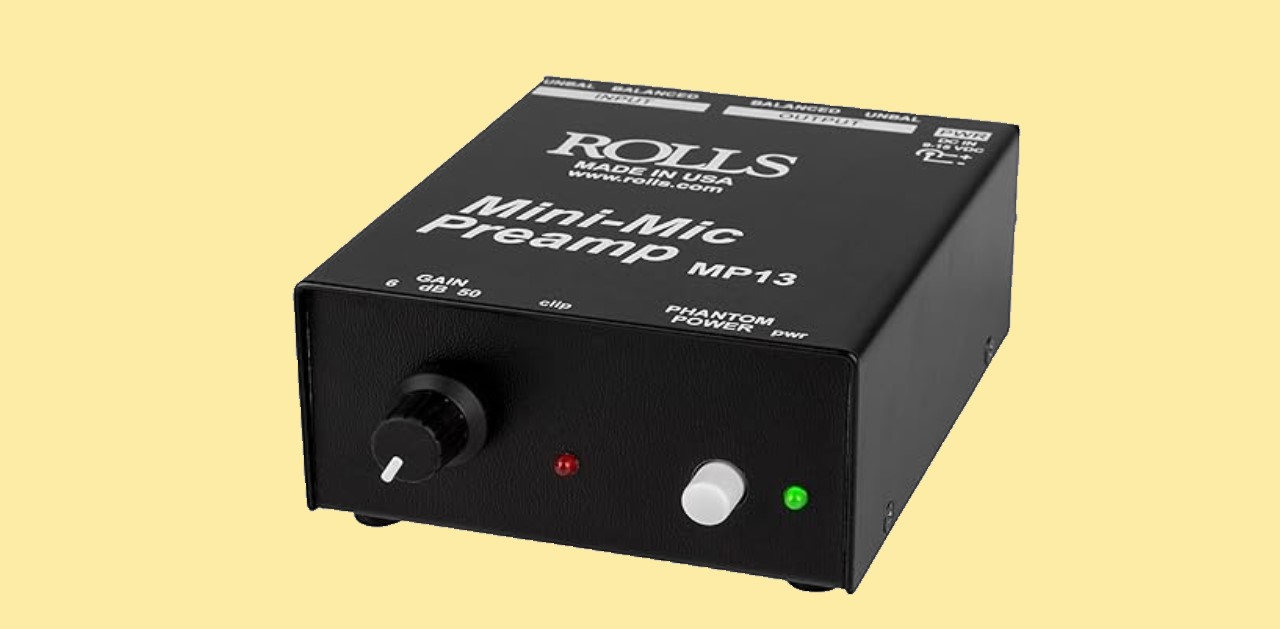
The MP13 is a small, simple, and inexpensive microphone pre amplifier for a variety of applications. Image Source.
Key Features
- Compact Design: Ideal for setups with limited space or for on-the-go recordings.
- Versatile Usage: Suitable for a variety of audio sources, from vocals to instruments.
- Plug and Play: No complex setups or configurations are required.
In the realm of audio equipment, the Rolls Mini Microphone Preamp emerges as an embodiment of simplicity combined with efficacy. This compact device, tailored for both novices venturing into audio recording and seasoned professionals desiring portability, is a testament to Rolls’ commitment to quality.
Its design ensures it seamlessly integrates into diverse recording environments. From capturing the subtle nuances of vocals to the vibrant tones of instruments, the Rolls Mini is adept at ensuring every sound is reproduced with utmost clarity.
Pros
- Highly portable, making it perfect for mobile setups.
- Intuitive design ensures ease of use for beginners.
- Delivers clear and precise audio amplification.
- Durable construction ensures longevity.
Cons
- Limited advanced features for professional setups.
- Might require external power in some scenarios.
2. TNP Mini Mixer Audio
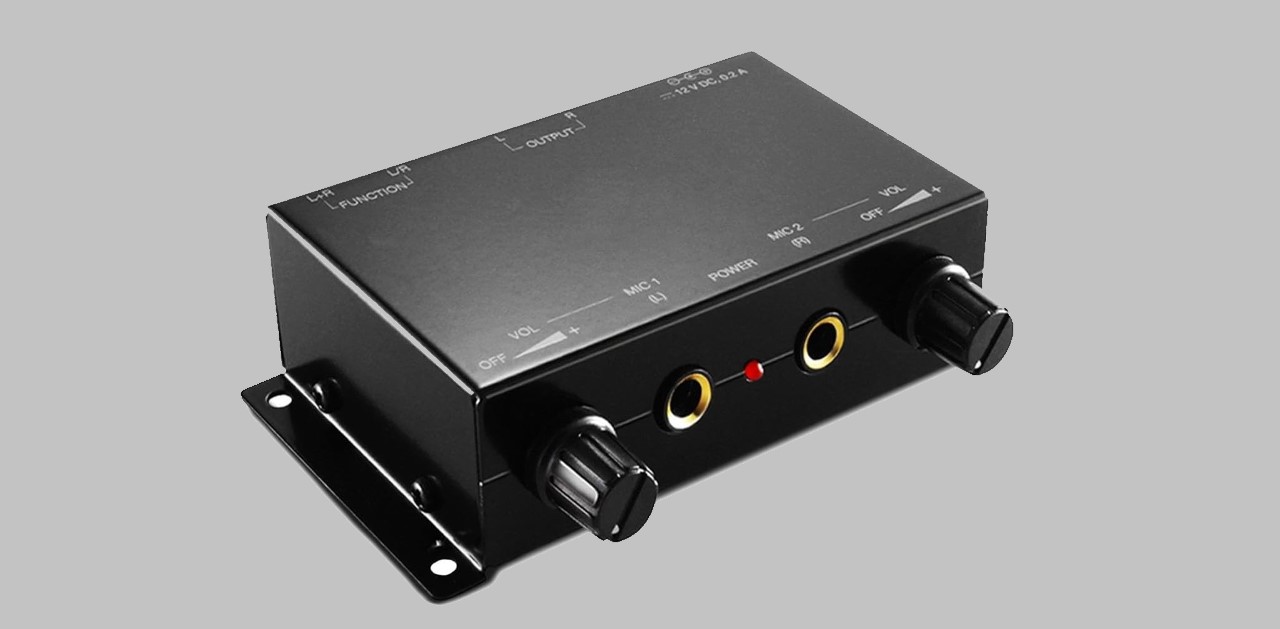
The TNP can be anchored to any stable surface for stability, ideal for on-the-go audio management. Image Source.
Key Features
- Multi-input Mixing: Allows for simultaneous mixing of multiple audio sources.
- Robust Build: Designed to withstand regular use without wear and tear.
- Intuitive Controls: Easily accessible knobs and switches for quick adjustments.
The TNP Mini Mixer Audio is not just another preamp; it’s an audio Swiss Army knife. Designed for those who juggle multiple audio sources, this device amplifies, mixes, and refines sound with precision. It’s an indispensable tool for podcasters weaving multiple narratives or musicians blending diverse instrumental sounds.
Built to last, its sturdy construction is complemented by an intuitive interface, making it a mainstay in many audio setups.
Pros
- Offers versatility with its multi-input capability.
- Sturdy construction promises long-term reliability.
- Suitable for both studio and live recording scenarios.
- User-friendly interface ensures quick mastery.
Cons
- Might be too complex for basic audio needs.
- Larger footprint compared to simpler preamps.
3. Presonus TubePre v2 Tube Preamplifier DI Box
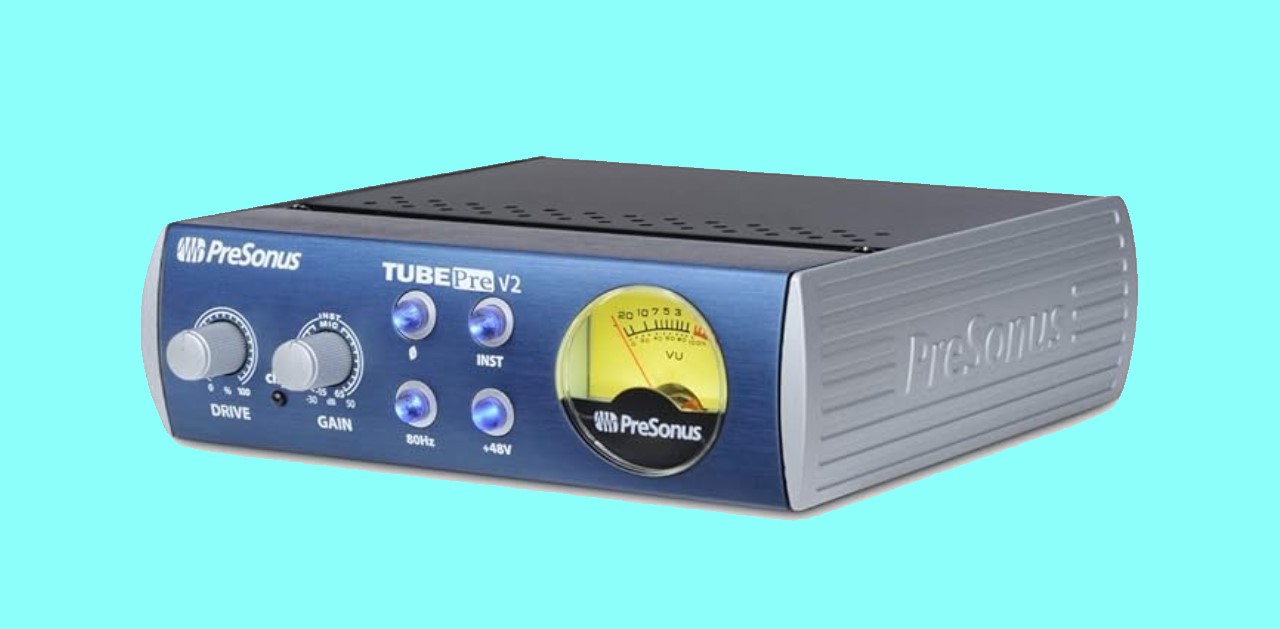
The TubePre v2 has gain control and tube drive saturation control. Image Source.
Key Features
- Tube-driven Design: Imparts a warm and rich tonal quality to recordings.
- Sturdy Build: Ensures durability and resistance to wear and tear.
- Variable Input Control: Allows for fine-tuning to match different audio sources.
Evoking the essence of yesteryear’s sound, the Presonus TubePre v2 is a nod to the golden age of audio recording. Its tube-driven architecture imparts a characteristic warmth and depth to the sound, reminiscent of iconic vintage tracks.
Musicians aiming for that nostalgic touch will find this preamp among many other budget microphone preamps to be an ally. Beyond its sound, its robust construction ensures it’s a companion that stands the test of time.
Pros
- Delivers a unique vintage sound signature.
- Robust construction ensures longevity.
- Versatile enough for various recording scenarios.
- Intuitive controls for ease of use.
Cons
- Might not be suitable for all genres.
- Requires careful handling due to tube components.
4. Cloud Microphones – Cloudlifter CL-1
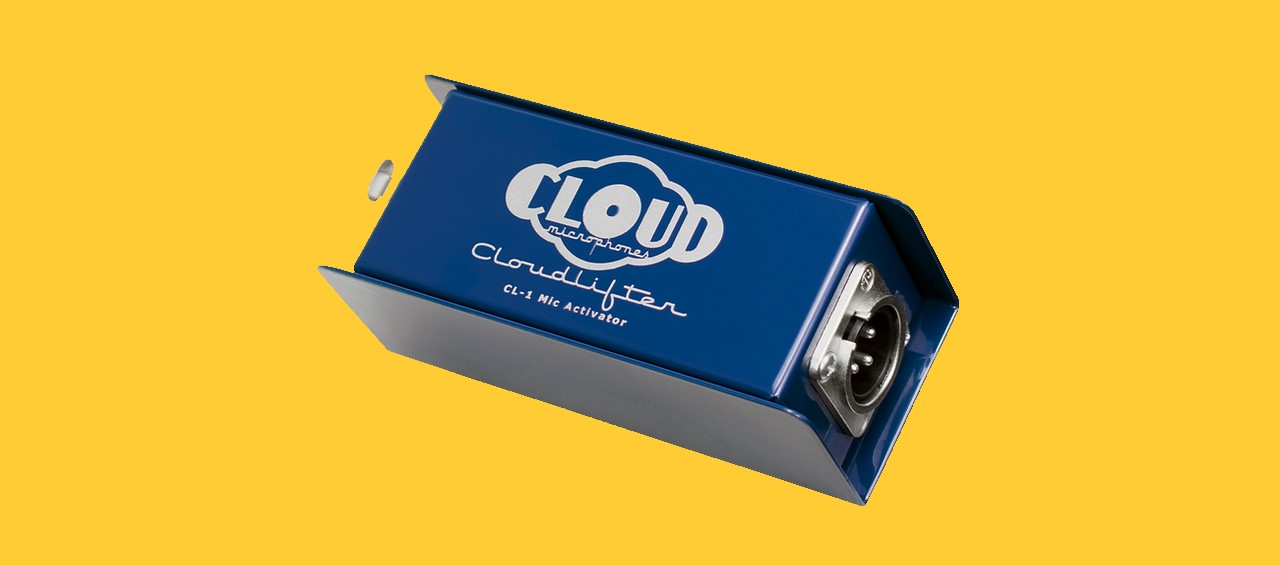
The Cloudlifter CL-1 mic activator uses Phantom power to give passive mics up to +25dB without passing Phantom power onto the mics themselves. Image Source.
Key Features
- Enhances Passive Microphones: Boosts the signal of passive mics without adding noise.
- Noise-free Recordings: Designed to eliminate interference and unwanted sounds.
- Compact Design: Easily fits into any recording setup.
In the quest for audio perfection, the Cloudlifter CL-1 emerges as a beacon for sound aficionados. Crafted by the maestros at Cloud Microphones, this device is engineered to amplify the prowess of passive microphones.
Its design philosophy revolves around purity, ensuring recordings are devoid of noise and interference. Compact yet powerful, it’s a testament to the fact that size isn’t always indicative of capability.
Pros
- Delivers high-quality audio amplification.
- Perfect for studio environments with its noise elimination.
- Compact and portable design.
- Suitable for a wide range of passive microphones.
Cons
- Might be on the pricier side for hobbyists.
- Specifically designed for passive mics, limiting its versatility.
5. Golden Age Project Pre-73 Jr Mic Pre
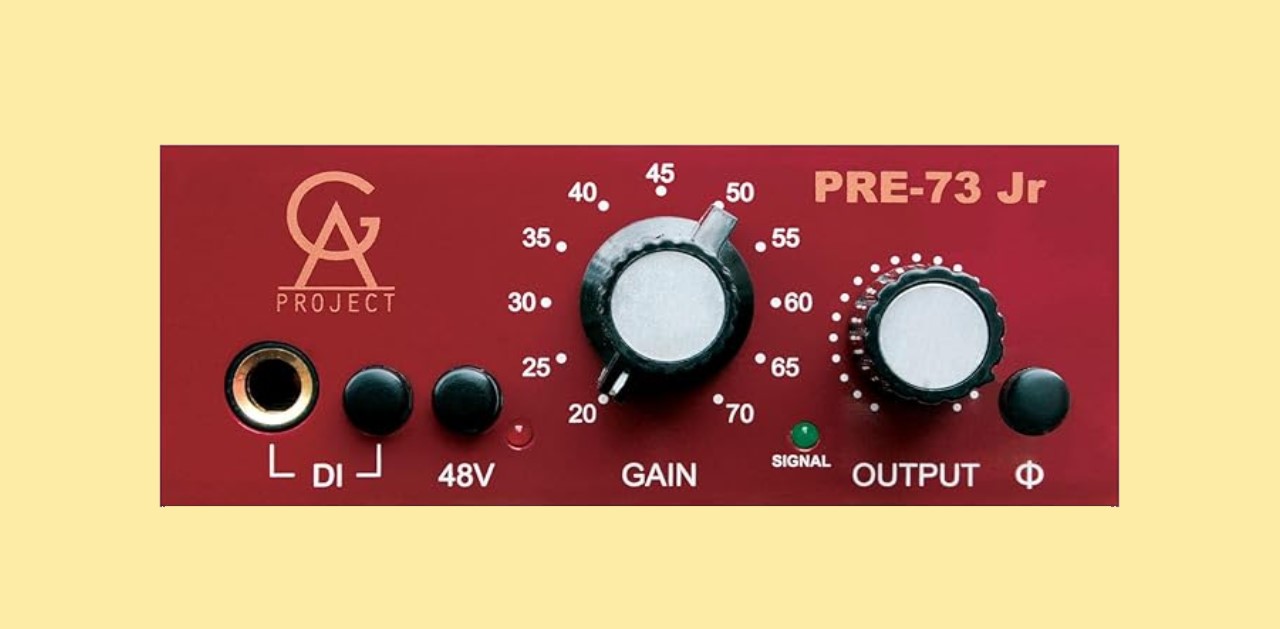
The Pre-73 Jr Mic Pre has a single-channel mic/instrument preamp with 70dB of gain. Image Source.
Key Features
- Vintage-inspired Design: Offers a sound profile reminiscent of classic preamps.
- Rich Audio Output: Ensures recordings are warm and full-bodied.
- Robust Construction: Built to last with high-quality materials.
Echoing the sonic brilliance of iconic preamps, the Golden Age Project Pre-73 Jr is a confluence of vintage charm and contemporary technology. Every aspect, from its design to its output, resonates with the ethos of the golden era of sound recording.
It’s a device that doesn’t just reproduce sound; it adds character, ensuring recordings that are both lucid and imbued with a distinct personality.
Pros
- Unique sound signature adds character to recordings.
- Durable construction ensures long-term use.
- Versatile enough for various audio sources.
- Easy-to-use interface for quick adjustments.
Cons
- Might be bulky for some mobile setups.
- Vintage sound might not suit all recording needs.
6. Focusrite ISA Single-channel Mic PreAmp
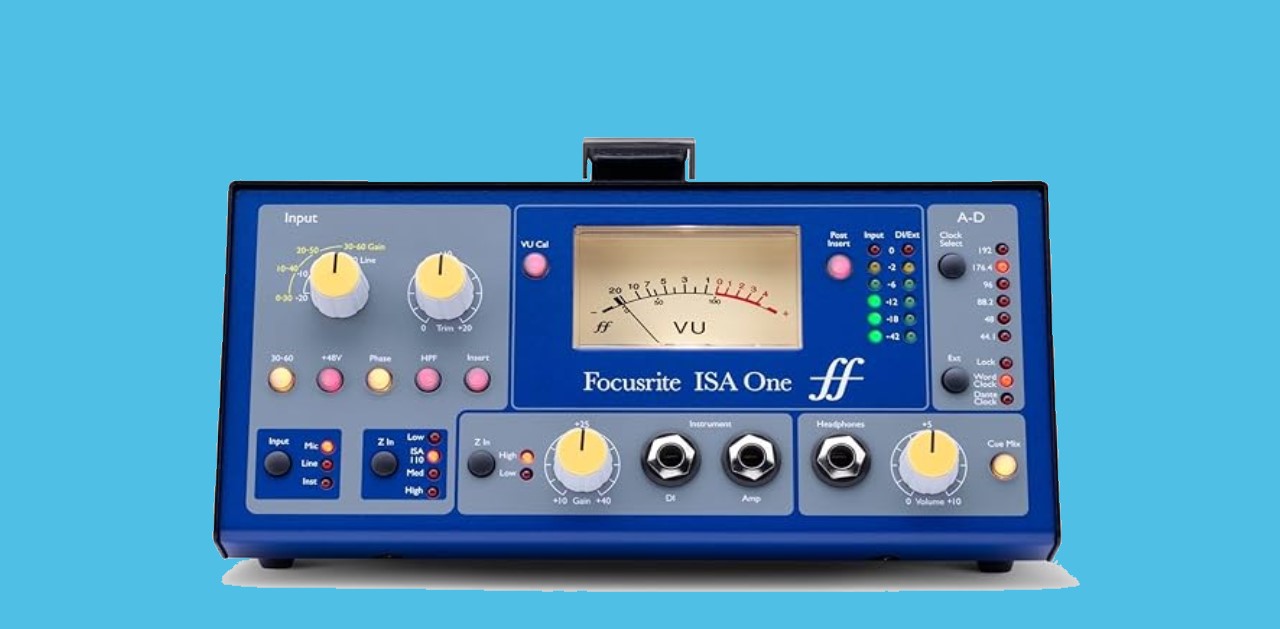
The Focusrite ISA One Classic is ideal for both engineers and demanding performers alike, featuring independent gain control, an output for routing to an amp. Image Source.
Key Features
- Premium Components: Ensures top-notch audio quality.
- Consistent Performance: Delivers reliable output in various scenarios.
- Robust Build: Designed for durability and longevity.
With a legacy steeped in excellence, Focusrite’s ISA Single-channel Mic PreAmp is a manifestation of audio engineering prowess. This device isn’t just about amplifying sound; it’s about refining and elevating it to a level of clarity that’s unparalleled.
Tailored for discerning professionals, its consistency in performance, whether in the sanctum of a studio or the dynamic environment of on-the-go recordings, is commendable.
Pros
- Renowned for its high-quality audio output.
- Suitable for both studio and on-the-go recordings.
- Durable construction promises long-term reliability.
- Intuitive controls for ease of use.
Cons
- Comes at a premium price point.
- Single-channel might limit its versatility for some users.
7. DBX 286s Microphone Preamp

The dbx 286s has frequency tuneable de-esser that reduces sibilance and high frequency distortion. Image Source.
Key Features
- Comprehensive Processing: Offers a range of tools to refine audio.
- Studio-quality Preamp: Ensures recordings are clear and detailed.
- Intuitive Design: Easily accessible controls for quick adjustments.
The DBX 286s is not merely a preamp; it’s an audio alchemist. Designed to transform rudimentary sounds into sonic gold, this device is a comprehensive solution for diverse audio needs. From its impeccable amplification capabilities to its suite of processing tools, it’s a device that caters to both the uninitiated and the seasoned, ensuring every recording is a masterpiece.
Pros
- All-in-one solution for various audio needs.
- Delivers studio-quality audio amplification.
- Built-in processing tools offer added versatility.
- Suitable for both beginners and professionals.
Cons
- Might be overkill for basic audio setups.
- Larger footprint compared to simpler preamps.
8. Behringer ADA8200 Mic Preamp

The Behringer ADA8200 is an 8-channel Microphone Preamplifier 24-bit 44.1/48kHz AD/DA Converter with ADAT Optical Out. Image Source.
Key Features
- 8 MIDAS-designed Preamps: Ensures top-notch audio quality.
- Versatile Connectivity: Offers a range of input and output options.
- Robust Construction: Built for durability and regular use.
Behringer’s ADA8200 is a testament to the power of modern audio technology. Armed with eight MIDAS-designed preamps, this behemoth ensures that every sound, from the faintest whisper to the most robust note, is captured with precision.
Beyond its amplification prowess, its versatility in connectivity makes it an indispensable tool for complex recording setups, be it a multi-instrument ensemble or a multi-guest podcast.
Pros
- Multi-channel support caters to complex setups.
- Delivers clear and detailed audio.
- Versatile connectivity options for various devices.
- MIDAS-designed preamps ensure premium sound quality.
Cons
- Bulky design might not suit all setups.
- Might be complex for basic audio needs.
Factors To Consider When Shopping For A Budget Mic Preamp
When diving into the world of audio recording, a microphone preamplifier, commonly known as a mic preamp, is a crucial piece of equipment. It amplifies the low-level signal from your microphone to a more usable level.
But with a plethora of options available, how do you choose the right one, especially when on a budget? Here are some factors to consider.
Price Vs. Quality
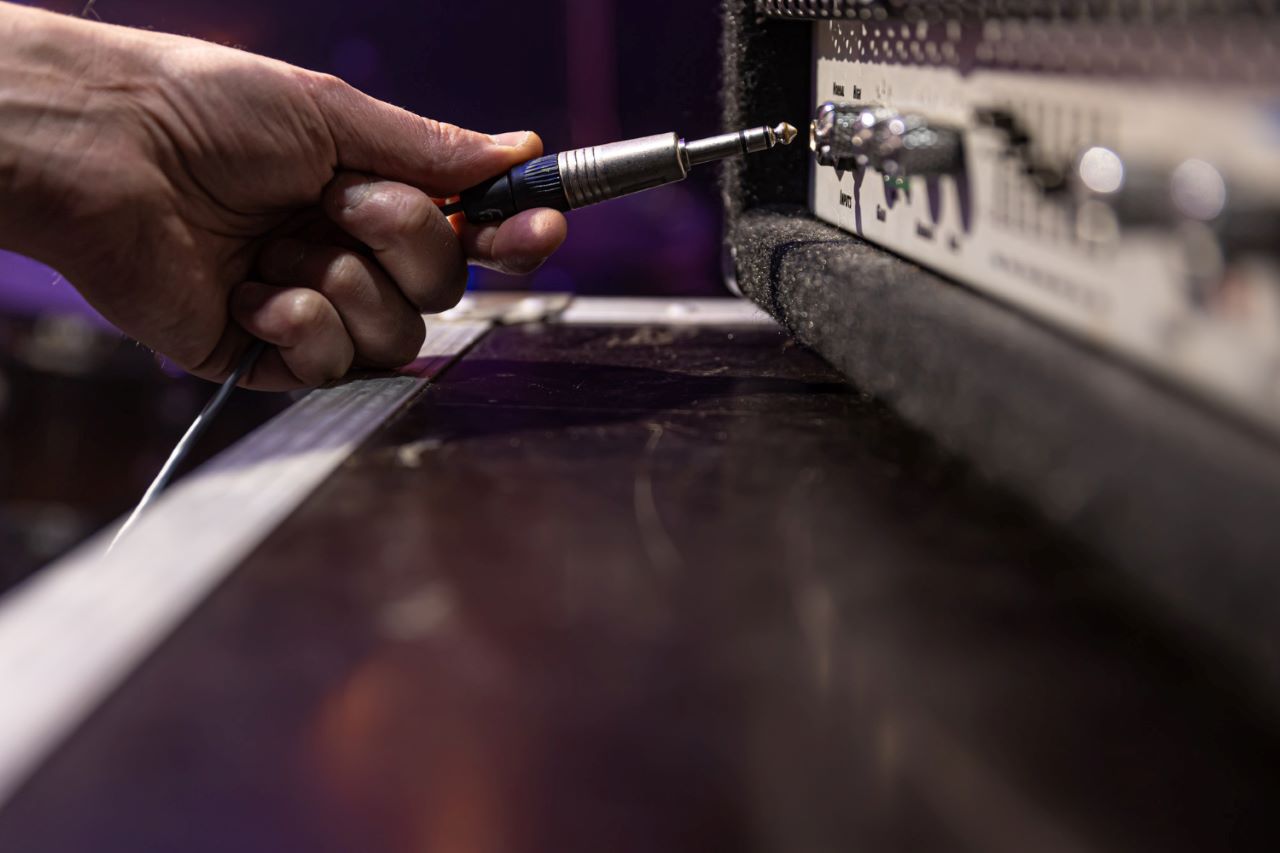
Image by pvproductions on Freepik
The audio equipment market is vast, with mic preamps ranging from as low as $50 to well over $1000. While it’s tempting to assume that higher prices guarantee better quality, this isn’t always the case. For instance, a study by the Audio Engineering Society found that in blind tests, listeners often couldn’t distinguish between high-end and budget preamps.
However, pricier models often offer better build quality, longevity, and nuanced features. It’s essential to determine your specific needs and research thoroughly to find a product that offers the best value for your budget.
Input And Output Options
The diversity in recording setups necessitates a variety of input and output options in mic preamps. For solo artists or podcasters, a single input might suffice. However, a report by the National Association of Music Merchants highlighted the growing trend of home studios, where multiple inputs for instruments and vocals become crucial.
Similarly, outputs determine how the preamp connects to mixers, computers, or speakers. Modern preamps often come with USB or Thunderbolt outputs, facilitating direct connections to computers for digital recording.
Additional Features
As technology advances, mic preamps are no longer just about amplification. A survey by Sound on Sound magazine revealed that many users value integrated features like digital converters, which transform analog signals into digital for computer recording.
Equalizers and compressors, once exclusive to high-end models, are now found in many budget-friendly preamps, offering users more control over their sound.
Phantom Power
Condenser microphones, popular for studio vocals due to their sensitivity and frequency response, require an external power source. This is provided by the preamp in the form of phantom power, typically at +48V. According to a market analysis by Future Market Insights, the demand for condenser microphones is on the rise, making phantom power an indispensable feature in modern preamps.
High-Pass Filters And Polarity Reverse
Environmental noises, like the hum from an air conditioner, often fall in the low-frequency range. High-pass filters allow users to eliminate these, ensuring cleaner recordings. Polarity reverse, on the other hand, is crucial for multi-mic setups.
A study in the Journal of the Audio Engineering Society highlighted phase issues that arise when multiple mics capture the same source, a problem rectified using the polarity reverse feature.
Metering Options And Pad
Visual feedback is crucial for optimal recording levels. LED or LCD metering, found in many modern preamps, provides real-time signal strength information, helping prevent clipping and distortion. Pads, which reduce input sensitivity, are essential when recording loud sources.
A survey by Pro Sound News magazine found that nearly 70% of users had inadvertently recorded distorted audio due to loud sources, underscoring the importance of pads.
Brand Reputation And Reviews
In the digital age, brand reputation plays a pivotal role in purchase decisions. A study by the Spiegel Research Center found that nearly 95% of shoppers read online reviews before making a purchase. Established brands not only offer quality assurance but also better post-purchase support.
However, it’s essential to differentiate between genuine user reviews and promotional content to make an informed decision.
Making The Most Of Your Budget Mic Preamp

Image by Freepik
Once you’ve made the investment in a mic preamp, it’s essential to ensure you’re getting the best out of it. Here’s how.
Proper Setup And Calibration
A well-calibrated preamp can significantly enhance audio quality. The Audio Engineering Society recommends periodic calibration, especially when working in unfamiliar environments. This ensures that the preamp operates within optimal parameters, delivering consistent performance. Proper setup, which includes ensuring secure connections and optimal gain settings, is equally crucial.
Integrating With Other Gear
A seamless integration of the preamp with other equipment, be it mixers, audio interfaces, or digital audio workstations, is vital for a smooth recording experience. A report by Music Trades magazine emphasized the growing trend of integrated home studios, where compatibility between different gear becomes paramount.
Ensuring that the preamp supports common connection standards, like XLR or TRS, can save users from potential headaches down the line.
Maintenance And Care
Like all electronic equipment, mic preamps have a lifespan that can be extended with proper care. The National Association of Professional Band Instrument Repair Technicians recommends keeping audio equipment in a dust-free environment and avoiding exposure to extreme temperatures.
Periodic cleaning, using soft cloths and isopropyl alcohol, can prevent buildup that might affect performance. Additionally, checking for firmware updates can ensure the preamp operates at its best.
The Evolution Of Mic Preamps
The world of audio recording has seen significant advancements over the decades, and mic preamps have been at the forefront of this evolution.
The Analog Era
In the early days of recording, preamps were purely analog devices. These vintage preamps, often tube-driven, are known for their warm and rich tonal quality. Musicians and producers of yesteryears relied on these to capture sounds that still resonate with many today.
The analog era emphasized the character and coloration that preamps added to the sound, making each preamp unique in its own right.
The Digital Revolution
With the advent of digital technology, preamps underwent a transformation. Modern preamps not only amplify but also convert analog signals into digital for computer recording. This shift brought about a clarity and precision previously unattainable.
However, it also sparked debates among audio purists about the ‘soul’ and ‘warmth’ of analog versus the ‘clarity’ and ‘precision’ of digital. Today, many preamps offer the best of both worlds, combining analog circuitry with digital conversion capabilities.
Mic Preamps In Different Recording Scenarios

Image by Freepik
Mic preamps, while universally designed to amplify microphone signals, can have varied applications depending on the recording scenario. The environment, the type of sound being captured, and the end goal of the recording all play a role in determining the ideal preamp for the situation.
Studio Recordings
Studio environments are meticulously crafted spaces where every sound detail matters. Here, the role of a preamp is not just to amplify but to preserve and sometimes enhance the richness of the sound.
In studios, the controlled environment allows for:
- Precision: The quiet and acoustically treated spaces mean that preamps can focus on capturing the subtle nuances of sound without external interferences.
- Versatility: Studio recordings can range from a solo vocalist to a full orchestra. Preamps in this setting need to handle a wide range of sound sources and frequencies.
Key Considerations For Studio Preamps
- Dynamic Range: The ability to capture both quiet and loud sounds without distortion.
- Coloration: Some studio preamps add a specific tonal color, which can be desirable for certain genres or effects.
- Connectivity: Integration with other studio equipment, from mixing boards to digital audio workstations.
Live Performances
Live performances come with their own set of challenges. The unpredictability of the environment, coupled with the need for real-time sound perfection, demands a lot from preamps.
In live scenarios:
- Durability: The hustle and bustle of live setups mean preamps need to withstand constant movement, potential knocks, and quick setups.
- Feedback Control: With speakers and mics in close proximity, managing feedback becomes crucial.
Key Considerations For Live Performance Preamps:
- Portability: Compact designs that are easy to transport and set up.
- Rugged Build: To withstand the rigors of live performances.
- Quick Adjustments: User-friendly interfaces that allow for on-the-fly tweaks.
Podcasting And Broadcasting
The digital age has seen an explosion in podcasting and online broadcasting. While the primary sound source is often spoken word, the need for clarity and consistency remains paramount.
For Podcasters And Broadcasters:
- Voice Clarity: Emphasis on frequencies that enhance vocal clarity, ensuring listeners receive clear and intelligible content.
- Integration with Digital Devices: Many podcasters operate from home studios or on-the-go, requiring preamps that can easily integrate with laptops, tablets, or even smartphones.
Key Considerations For Podcasting And Broadcasting Preamps:
- USB Connectivity: Direct connection to digital devices for easy recording.
- Noise Gates or Voice Enhancers: Built-in features that enhance voice recordings.
- Compact Design: Especially for podcasters on-the-move, a smaller footprint can be beneficial.
FAQs

Image by Freepik
What Is A Good Mic Preamp?
A good mic preamp is a device that amplifies the low-level signal from a microphone to a level suitable for recording or broadcasting. But beyond this basic function, several factors define a “good” preamp:
- Sound Quality: A top-tier preamp should offer clear, noise-free amplification, preserving the microphone’s original sound without introducing unwanted coloration or distortion.
- Build Quality: Durability is crucial. A good preamp should be robustly built to withstand regular use, ensuring longevity.
- Features: Modern preamps often come with additional features like phantom power, high-pass filters, and digital converters. While not all users might need these, they can be invaluable for specific recording scenarios.
- Value for Money: A good preamp should offer a balance between its price and the features it provides, ensuring users get the best bang for their buck.
- Versatility: Suitable for various microphones and recording scenarios.
- User-friendly Interface: Intuitive controls and clear labeling for ease of use.
Do I Really Need A Mic Preamp?
While many audio interfaces and mixers come with built-in preamps, a standalone mic preamp can offer several advantages. Firstly, it provides a dedicated amplification pathway, often resulting in superior sound quality. Secondly, standalone preamps often come with additional features not found in built-in variants, offering users more control over their sound.
Lastly, for microphones that require a lot of gain, like ribbon or some dynamic mics, a dedicated preamp can provide the necessary boost without introducing noise. However, for casual users or those on a tight budget, built-in preamps in quality audio interfaces might suffice.
Does A Preamp Improve Sound Quality?
Absolutely. A preamp plays a pivotal role in determining the overall sound quality of a recording. By amplifying the microphone’s signal, it ensures that the subsequent recording or broadcasting equipment receives a strong, clear signal. A high-quality preamp will amplify this signal without introducing noise, distortion, or unwanted coloration.
Moreover, many modern preamps come with features like equalization or compression, allowing users to refine their sound further. In essence, while a preamp’s primary job is amplification, its impact on sound quality is profound.
- Noise Reduction: Quality preamps introduce minimal noise during amplification.
- Tonal Enhancement: Some preamps add a warm, analog tone, enhancing the overall sound.
Should I Upgrade My Mic Or Preamp?
This is a common dilemma for many in the audio recording realm. The answer largely depends on your current setup and recording goals. If you’re using a budget microphone with a high-end preamp, upgrading the microphone will likely result in a more noticeable improvement in sound quality. Conversely, if you have a professional-grade microphone but are using a basic, built-in preamp, investing in a dedicated preamp can elevate your recordings.
However, it’s essential to consider the synergy between the two. A top-tier microphone paired with a mediocre preamp might not deliver its full potential, and vice versa. When deciding which to upgrade, consider your budget, current equipment quality, and recording needs. Often, consulting online reviews, user feedback, or professionals in the field can provide insights tailored to your specific situation.
Related: Best Audio Interface Under 500 Dollars
Conclusion
The realm of audio recording is vast and intricate, with mic preamps standing as one of its most pivotal components. These devices, often overlooked by novices, play a crucial role in determining the overall quality of sound recordings. As we’ve journeyed through the intricacies of preamps, from their fundamental functions to the myriad of features they offer, it’s evident that they are more than just mere amplifiers. They are the gatekeepers of sound quality, ensuring that every nuance, every tone, and every detail is captured with precision and clarity.
Different recording scenarios, be it in a controlled studio environment, the dynamic setting of a live performance, or the digital domain of podcasting, each come with their unique challenges. The right preamp, tailored to the specific needs of these scenarios, can make all the difference. It can be the difference between a recording that sounds amateurish and one that resonates with professional quality.
Among the plethora of options we discussed, one product that particularly stands out and has garnered our personal favor is the Cloud Microphones – Cloudlifter CL-1. Its ability to enhance the performance of passive microphones, combined with its promise of noise-free recordings, makes it a gem in the world of preamps.
Its compact design, coupled with its high-quality audio output, positions it as a must-have for both professionals and enthusiasts. While every product has its merits, the Cloudlifter CL-1 strikes a balance between functionality, quality, and value.